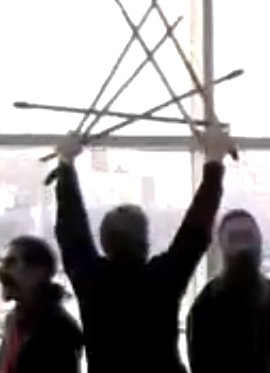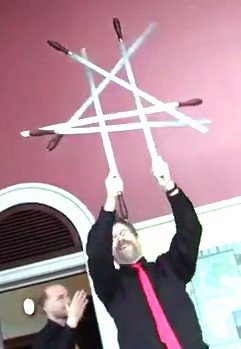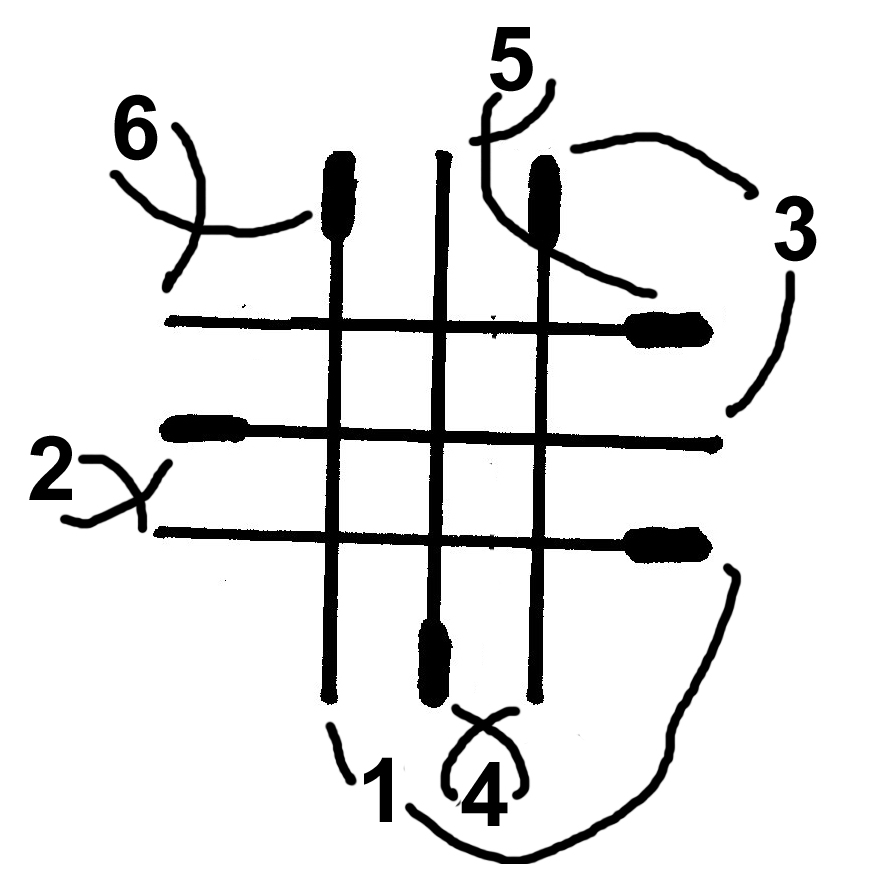by Douglas Allchin
Douglas Allchin has been a morris dancer since 1984. He has danced with 9 different teams, and adapted and written many morris dances. He was a founding member of the longsword team Guyz with Tiez in St. Paul, Minnesota in 2008.
Traditional longsword dances from northern England might easily be susceptible to the unflattering (but not uncommon) stereotype of being overly tedious and stale. Six dancers, linked in a ring holding stylized “swords,” tread ceremoniously, while lowering or raising particular swords, stepping over or passing under them, repeating each move six times (once for each dancer’s sword), maintaining an unrelenting steady pace to a rhythmic but sometimes repetitive tune. However, a few longsword teams have ventured into creative approaches [Barrand, Anthony. 2006. Dancing with swords in the DVRA, Part 1: Longsword. American Morris Newsletter, 26(2).] . Here, in the spirit of further reinvigorating the tradition, I report on another new longsword dance, consisting mostly of original figures and including a series of new locks: those self-supporting arrangements of interwoven swords presented aloft to the audience.
The dance is called “Lock and Dam.” The title refers to an engineering feature of the Mississippi River. Several dams punctuate the river channel, and boats navigate the change in levels through a series of locks. Lock and Dam #1 is situated in downtown Minneapolis, Minnesota, where the dance originated. The imagery of the dance evokes the river, with various spinning gestures and undulating waves reminiscent of the twirling turbulence and flow of the river’s water. The second reference is more familiar to sword dancers, and refers to the use of seven different sword locks displayed in the course of the dance.

The dance is unique in being based on a 12-count phrase, rather than an 8- or 16-count phrase. The appropriate music is a 3/2 hornpipe, such as “Three Rusty Swords,” “The Dusty Miller,” or “The Presbyterian” (sample one). To provide for a more dance-like quality, in contrast to mere walking, the 12th beat of the phrase features a modest back step, as a gentle form of kinetic punctuation.
The dance figures in detail are as follows. The opening begins with a simple unlinked ring, with swords resting on the shoulder. At the end of the phrase, the dancers swirl tightly out to the right, and on the 12th beat, step back into two facing lines. The lines cross through, passing right shoulders and clashing swords, then circle clockwise. At the end of the next phrase, the tight twirl out goes to the left and the Cross-and-Clash is repeated, passing left shoulders and turning into a counterclockwise circle. All dancers then make another tight twirl to the right and lower swords to form the sword ring. The first Chorus follows.
The Chorus is a simple ring movement with a flourish of the swords that reverses the direction of the dancers. Swords are generally held with the tip in the center of the circle, forming spokes of a wheel rather than a peripheral ring. The tips are then raised, and in a circular motion, lowered again, followed by the raising of the hilts, which then fold into the center of the set (as the tips move out) and the dancers all pivot (on the 12th-beat back step) and continue stepping briskly in the opposite direction. The gesture is essentially repeated again to resume the original direction. This figure was named Flexagon (referring to the similar folding action of a paper polygon puzzle made popular by Martin Gardner).
The dancers use the 12th-beat back step to reverse direction. Another modified Flexagon is performed. In one fluid motion the hilts (now on the inside) are lifted into a central column, then lowered, slid out, raised, guided in and down (one large circle with the right arm). Meanwhile, the tips (in the left hand) are slid to the center, then swept out, up, in, down, and out again. In all, the arms have made two grand opposing circles. Grips are now overhand. At the beginning of the next phrase, all dancers, still circling clockwise, raise swords, pivot clockwise (turning over right shoulder) and face in. This allows them to form a standard (6-pointed) lock.
The lock is displayed as the dancers open into two facing lines on the 12th-beat back step (as in the Opening). The lines cross, passing right shoulders, then turn right and circle. On the next back step, the lines reform, and cross passing left shoulders. The lock is lowered, swords are drawn through and grabbed by the left hands. The Flexagon Chorus follows.
The first figure is a variant of double-under. The variation is to continue the figure, revolving several times, allowing the revolving horizontal swords to take opposing poles: Paddlewheel.
On a subsequent pass, dancers #3-#6 consolidate in a square. #1 and #2 (holding #1’s sword), rather than leading through the bridge under #4’s sword, pass under all 4 dancers as they jump: a figure called Four-Up. Just for dramatic effect, #1 and #2 carry the sword over the dancers’ heads again and swoop down to pass under the four jumping dancers a second time.
As #1 and #2 return the sword over the other dancers’ heads again, they bring the swords on the inside of the set, collapsing the six swords into three anti-parallel pairs. With modest passing of hilts and tips, the dancers are now divided into three pairs. The dancers separate and begin an Over-Under Hey.
After 2 full passes, the pairs switch, using the 12th-beat back step as a lead-in, into a Horizontal Hey. The 12-beat music allows all six dancers to align on the back step, a small visual punctuation.

[Allsop, Ivor & Barrand, Anthony (Eds.). 1996. Longsword Dances from Traditional and Manuscript Sources. Brattleboro, VT: Northern Harmony.] . Odds are now on the left of each pair. All raise their right hand (hilt). As the set collapses, Odds will meet a new Even on their left. Odd right hand goes over Even right hand, Odd left hand over Even left hand. The lock virtually forms itself as the swords move in, with a final weaving of the tips on the outside corners by the left hands. On this particular occasion, the dance uses a slight variant of the Kirkby Lock. #1 passes the #1 hilt over the #2 sword to the left hand, while the #2 tip is transferred to the right. The paired (anti-parallel) swords enter the lock as an “X”. The hilts of those 2 swords are now slid further into the lock: the Star Trek Delta Lock (Figure 2). This lock variant was first conceptualized by Andy Kedl, of Guyz with Tiez.
The lock is displayed as the dancers form the two lines which pass through and circle twice. Flexagon Chorus.
The next figure is a variant of the traditional single guard. #1 raises swords and turns back and circles the set: the familiar single guard. Then #1 turns again followed by #6, who raises the trailing sword: “double guard.” On the third phrase, #1 is followed by #6 and also #5: “triple guard”. On the fourth phrase, all the dancers follow, inverting the set: a figure collectively known as Progressive Guard.
The next lock is an adaptation of one that we trace to Rick Mohr. While walking clockwise (inverted), Odds progress one position (past Evens). All turn over their left shoulder to face in. Odds form an interior triangle with their 3 swords. The remaining 3 swords are woven in, forming an exterior triangle rotated 60 degrees to the interior one: the Rick-Mohr Lock. (Forming the lock from an inverted set was my own innovation.)
The lock is shown. Dancers do their standard pass through and rounds, but on this occasion undoing the lock requires a special sequence. Dancers pass through only once, passing left shoulders and then circle counterclockwise. #1 lowers the lock upside-down (accommodating the earlier set inversion). Dancers re-grab and as the phrase ends, Odds step in and allow the Evens to pass outside them, returning to their original position as the lock opens. Flexagon chorus.
The next figure starts as the Odds bring their hilts high and fold their swords inward, stepping in to the center. There are now 3 spokes of paired swords. The wheel rotates, Evens on the outside. On the next phrase, the spokes are inverted: namely, the Odd hilts and Even tips arch up and outward, as the Odds step out. The Evens step in, sweeping under with their own hilts and Odd tips, raising them in the center before settling them again at waist level. This alternation repeats several times: a figure called Odds and Evens.
On the third cycle (say), the Odds pass their tips back and accept the new tips. The set is now separated again into three pairs of anti-parallel swords. As the new phrase begins, each spoke-pair spins as a pair to the outside (clockwise). They spin 360 degrees and reform the spoked wheel. The wheel rotates again. On the new phrase, each pair spins again, but a forceful 540 degrees, reforming the spoked wheel that now rotates in the reverse (clockwise) direction: the figure called Propellor (yet another visual allusion to the turbulent water theme)

As the music begins a new phrase, the pairs spin again to the outside (this time, counterclockwise), spinning 270 degrees to face into the set. Odds cross hilts over to their left hand, tips under to the right hand. The lock is formed using the standard Kirkby Malzeard method (described above): the Bill Morelock (named after a local classical radio personality).
A pass-through, circle and Flexagon Chorus leads to the next figure. #1 begins the basic movements of a single guard (turning out over the right shoulder). However, the other dancers now remain still. At the same time, #4 begins a “reverse” single guard, turning out over the left shoulder rather than the right. #1 and #4 soon meet, #1 passes on the outside, swords high. On the opposite side of the set, #4 passes on the outside. The other dancers adjust their hand heights to accommodate the sword movements. #1 and #4 return to place. The figure is repeated with #2 and #5, and then with #3 and #6: the figure called Helicopter.

As a lead-in to the next lock, Helicopter is performed once again (#4 lead, #1 anti-pole). As they return to position, the set opens, #1 and #4 pass through the set, passing left shoulders and gypsying 180 degrees. All now face in, circling counterclockwise. #1 and #4 form a central diamond with their swords. Without any release, the remaining two swords are woven along the side. Step back and show: the Argyle Lock (Figure 4). I envisioned this new lock myself, and then worked out the mechanism for forming it without breaking the ring.
Again, two pass-throughs, with circling. The lock is undone by reversing the motions, #1 and #4 crossing through, passing right shoulders. Flexagon Chorus.
The next figure draws on familiar elements in a special combination. The sequence is prepped by doing Single Under with #5 starting under #6’s sword, then #6 under #1’s sword. #1 follows the sequence, passing under #2’s sword, turning left. But on this third occasion, each dancer turns to an alternate side (Evens to the right, Odds to the left), lifting their sword and adding it to the raised ensemble. Each set of 3 dancers rotates, and the assemblage of six swords rolls above: Bridge (also called Meat Grinder by others).
The key variation is on exiting the figure. #1 crosses the gap and begins circling on the other side. Other Odds follow, lowering their swords and taking their respective positions in the ring. The set is now inverted: prime position for a lock. However, during the transition, #1 has surreptitiously removed his sword from the ring, bringing the tip of #6’s sword to the left hand of #2.

The five remaining dancers form the standard 5-sword star lock. #4 shows the lock, #1 the sole stray sword: the 5 + 1 “Lock”. All dancers take note of the mistake: “Damn!” The lock is lowered, the point closest to #1 is opened, and the wayward sword woven in and the new lock shown again: the Bridge Lock (Figure 5). The new lock pattern and the mechanism for forming it were also worked out by me.
Pass-through sequence and Flexagon Chorus.
The final figure sequence again begins with a familiar figure. #6 and #1 pair behind #6’s sword for Double Under (under #3’s sword). The figure progresses by position, next under #1’s sword, then #2’s. Here, there is a reprise of Paddlewheel, with the #2 and #5 swords at opposite sides of the circular sweep.
The transition to the next figure is tricky, but the ultimate effect is quite dramatic: the swords switch from revolving cylindrically around a horizontal axis, to spinning on two vertical axes. After passing under the #5 sword, #4 crosses in front of #3, under #3’s sword (passing by the left shoulders) turns inwards, and brings the #3 sword down next to his own sword. #4-3 pass under the #2 and #5 swords, now joined together, and being rotating right with #5 as a threesome. Symmetrically, #1 passes under his own sword, turning right shoulder, brings it down next to the #6 sword. #1-2 go under #5-#2 swords, turn left with #6. Each line turns twice: the figure called Eggbeater.

The final lock flows naturally from this sequence. From Eggbeater, after passing around #5, #3 and 4 pass around each other (gypsy) an extra 360 degrees, while #1-2 pass around #6. All face in, now in a circle. Circling continues counterclockwise while the lock is formed. The swords align in a simple square checkerboard weave, the infamous Portcullis Lock, as shown Figure 6. Note that here, it is easier for #1 to weave his hilt under the tip of #3’s sword, re-grabbing to pull and extend it fully: a small “cheat” that converts an authentic-but-awkward position into a smooth and convenient move. We have not found documentation for making this well-known lock without breaking the ring, or through a mechanism that is as easy as we have discovered.Show the lock and complete the standard cross-through sequence. The elegant challenge of the Portcullis Lock is to also undo this lock smoothly. #1 undoes the final weave-under and re-grabs. Now all the swords slide outward. #1 and #2 gypsy around each other, while #3 and #4 do the same. The circle is restored.
In our closing, the “Cross-and-Clash” sequence of the opening is reprised. The circle breaks and #1 leads the unraveling line to face the audience.
These are the basic notes. As in any dance, dancers need to negotiate and accustom themselves to the nuances of motion and transition at each particular position. Practiced efficiency on the locks is essential if the pace of the dance is not to be compromised. Careful planning and adjustment can also align the end of figures and choruses with the end of long phrases of the music, convenient for changing tunes.
The complete sequence is summarized briefly below. Like the Mississippi River itself, whose eddying water movements provided inspiration, the dance is long—in the range of 10½ minutes. We often perform only one-half at a time, using the opening and closing sequence and three of the figure-lock combinations.
Lock and Dam Sequence of Figures
- Cross & Clash (Processional)
- Chorus
- Hexaflexagon
- Standard Lock / Chorus
- Paddle-Wheel
- 4-Up (Ankle-Biter)
- Vertical and Horizontal Heys
- Star Trek Delta Lock / Chorus
- Progressive Guard
- Rick Mohr-Lock / Chorus
- Odds & Evens
- Propellor
- Bill MoreLock / Chorus
- Helicopter
- Argyle Lock / Chorus
- Single-Under into Bridge
- 5+1 Lock
- Bridge Lock / Chorus
- Double-Under into Paddle-Wheel
- Eggbeater
- Portcullis Lock / Chorus
- Cross & Clash (Recessional)
A final note on the locks. The Standard Lock, Kirkby Malzeard Lock, and Portcullis Lock are all well known [Allsop, Ivor & Barrand, Anthony (Eds.). 1996. Longsword Dances from Traditional and Manuscript Sources. Brattleboro, VT: Northern Harmony.] . The Bill Morelock and Star Trek Delta Lock are adaptations of the Kirkby Lock, but we have not encountered other teams using or recording them, or forming them with such efficient mechanisms. We are indebted to Rick Mohr for his lock, which we note is a radially symmetrical lock that goes beyond those in Krause’s 1990 review [Krause, Rhett. 1990. Review of rapper and longsword locks. Country Dance and Song, 20: 34-39.] . The Argyle Lock and Bridge Lock are symmetrical also—although bilaterally along a mirror-image line, not radially around a central point. These last two locks have not yet been documented, so far as we know, and seem to open the way to developing other such unfamiliar locks. Presenting them all in this dance, along with the other new figures and adaptations, is an implicit invitation for others to innovate further in the longsword tradition.
Acknowledgments
All the figures and locks, as well as the sequence, are my own choreography except where noted. The dance was developed as a team effort with Guyz with Tiez, who helped sample, test, explore, tinker, and develop each move leading to its performance.

 Thanks to the Massachusetts Cultural Council for their generous support.
Thanks to the Massachusetts Cultural Council for their generous support.